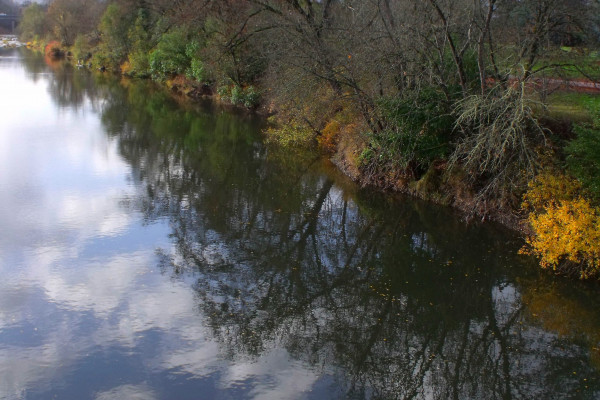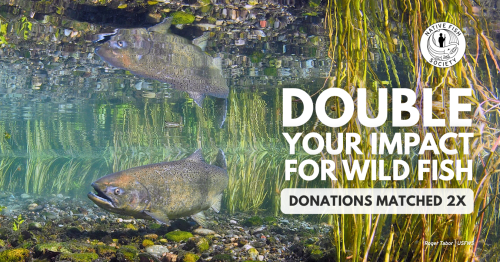River Stats:
Length: 115 miles long
Location: South Fork of Umpqua River in Southern Oregon
Threats:
Exotic, invasive small mouth bass
Hatchery fish production
Industrial logging
In-stream mining
Natural gas transportation line
Urbanization
South Umpqua River
The South Umpqua River is a temperature sensitive river of extremes. At once it is a river of untamed wilderness at its utmost upper reaches and the epitome of domestication as it merges down river with the main stem of the Umpqua Watershed Basin near Roseburg, Oregon. United with the Umpqua River it is the longest stretch of river on the West Coast without the impediment of a dam. From the confluence of the North Fork of the Umpqua River to its remote origins located in the High Cascades of Umpqua National Forest, the South Umpqua is estimated to be 115 miles long. From the Pacific Ocean to the head waters of Black Rock Creek and Castle Rock Creek near Fish Mountain, 228 miles is traversed.
1.2 million acres of land, made up of 13 fifth field watersheds, feeds over 1,000 miles of the South Umpqua basin’s anadromous salmonid spawning and rearing habitat streams. Hundreds more miles of instream habitat that comprise the river system are occupied by fluvial and resident trout. Although this river’s extensive reach spans several unique geological and ecological zones, 39 to 60 inches of rain swell the river each winter. The precipitation of the winter months morphs even the smallest streams feeding the main stem into raging torrents. The summer months on the other hand expose long spans of ancient and worn volcanic bedrock because of low river flows. The river lacks a significant Cascade lake discharge, so temperature extremes due to low flows of summer are another major fish endangering concern.
From ancient times the aboriginal peoples of the South Umpqua Basin depended extensively upon the abundant gift economy of the south Umpqua River. Large year around villages were sustained by the river’s varied aquatic species and fish populations. Native fish species known to inhabit the river prior to European contact are Steelhead (Oncorhynchus mykiss) (Anadromous, Fluvial and Resident ) (Summer and Winter runs), Coho Salmon (Oncorhynchus kisutch) (Anadromous), Chinook Salmon (Oncorhynchus tshawytscha) (Anadromous), (Spring and Fall runs), Chum Salmon (Oncorhynchus keta) (Anadromous), Cutthroat Trout (Oncorhynchus clarkii) (Anadromous, Fluvial and Resident), Western Brook Lamprey (Lampetra richardsonii), Pacific Lamprey (Lampetra tridentata), Umpqua Dace (Rhyinichthis evermanni), Sculpin (Cottus sp.), Redside Shiner (Richardsonius balteatus), Largescale Sucker (Catostomus marcochelius), Umpqua Pikeminnow (Ptychoncheilus oregonenis), Umpqua Chub (Oregonichthuys kalawatseti).
So opulent were the resources of the South Umpqua region that it was one of the first to be ruthlessly stripped of its natural and ecological treasures. Large tracts of land were settled and developed. First to be taken were the verdant forests of the river’s alluvial flood planes including the desperately needed riparian vegetation that provided the river with cooling shade. Even up until the late 1980′s riparian forests were mined of their large premium quality ancient trees. Both agricultural and logging practices were unsustainable. The quintessential ecological rhythms that derived their aquatic heartbeat from the rich ebb and flow of the South Umpqua River have been fundamentally maligned. Management regimes destabilized a significant majority of the riparian areas feeding the river. The tributaries of the river have been seriously incised because of extensive mechanical disturbance and woody debris removal. Vast quantities of spawning grade aggregate materials were swept all the way downriver into the Umpqua Coastal Estuary. The deep pools born of natural stream complexity have vanished leaving in their wake the raw hostile simplicity of volcanic bed rock. These changes in channel conditions have threatened every native fish species of the system.
The summer steelhead run of the South Umpqua is now extinct. The Chinook and Coho salmon runs are on the brink of collapse. As recent as the 1960s, hundreds of thousands of lamprey spawned in the system. In the last 20 years lamprey numbers have dropped to near zero. Anecdotal evidence and traditional ecological knowledge claim that chum salmon utilized reaches of this river system for spawning also. History is all that remains of their presence in the basin.
Efforts to compensate for the travesty of the failing native fish runs by planting hatchery reared steelhead and Coho salmon have only added to the elements impairing wild fish recovery efforts. Exotic and predatory small mouth bass take an extensive toll on young salmonids , lamprey larva and the now endangered South Umpqua chub. The economic benefits of marketing the South Umpqua River as world class trophy bass fishing river have eclipsed the ecological importance of the keystone native fish species. Salmon populations have been decimated by this exotic invasive predatory fish. Prime salmon spawning habitat and the river system itself is being placed in jeopardy due to an attempt to pass a three-foot diameter natural gas transport pipe line in two locations through the very bedrock layer of the river. One of the oldest operating smolt traps in the State of Oregon is stationed in the South Umpqua River. The upper regions of the South Umpqua have supported up to 70,000 salmonid smolts as recently as the early 1990s. That figure dropped to as low as 15,000 by the mid 1990s indicating a radical systemic collapse of river ecology supporting wild steelhead, Coho and Chinook populations.
The entire South Umpqua basin is labeled a key watershed under the Northwest Forest Plan. The river itself is contained in the Upper Umpqua ESU (Environmentally Sensitive Unit) and plays a strategic role in the Oregon Coastal Recovery Domain. The local citizen-based watershed councils are addressing manmade barriers of salmonid migrations to spawning grounds and smolt migrations to the estuary. Large woody debris and stabilizing boulder structures are gradually being replaced into the river system tributaries to rebuild the complexity of aquatic habitat, retain spawning gravels and provide fish refugia during the winter months. Utilization of another keystone species, the beaver, is being integrated into the basin’s restoration project plans. Beavers were an essential component contributing to perennial stream flows historically characteristics of the region and abundant fish populations. To quantify restoration project successes, extensive temperature, water quality, water flow rates and fish counts are being monitored. Grass roots efforts to halt the degrading wild fish runs and rectify the wrongs are growing. Land owners are participating in riparian planting regimes to attract beavers, supply shade and replenish large wood for future utilization by the river system. The South Umpqua River system is resilient. We refuse to accept it as an industrial or politically motivated natural resource sacrifice zone. The “people of place” are taking responsibility and ownership of the stewardship mentality needed to adapt and reverse the tide. Every helping hand is vigorously welcomed.
Video and Editing by Dan Amos, Agent of the Wild

